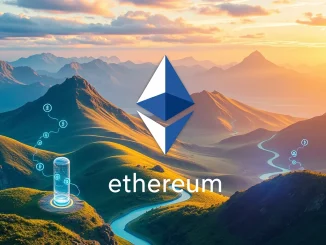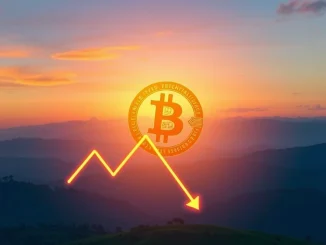
Hold onto your hats, crypto enthusiasts! January witnessed an explosive surge in network activity on Solana (SOL), culminating in a jaw-dropping $550 million in monthly Solana transaction fees. This isn’t just a bump in the road; it’s a monumental leap, smashing previous records and signaling a potentially transformative phase for the high-speed blockchain. According to data from crypto insights platform Unfolded, this figure represents a new peak for Solana, prompting both excitement and scrutiny within the crypto community. But what exactly fueled this dramatic increase, and what does it mean for you, the everyday crypto user or investor? Let’s dive deep into the numbers and unpack this fascinating development.
Why Did Solana Transaction Fees Explode to a Record High?
To understand this record-breaking milestone, we need to explore the driving forces behind the surge in Solana transaction fees. Several factors likely contributed to this impressive figure, reflecting the dynamic nature of the crypto market and Solana’s growing ecosystem:
- Increased Network Activity: The most straightforward explanation is a significant uptick in activity on the Solana blockchain. More transactions mean more fees. This surge could be attributed to a variety of reasons, including:
- Meme Coin Mania: January often sees a resurgence in meme coin trading. Solana has become a popular platform for launching and trading meme coins due to its speed and lower fees compared to Ethereum. Increased meme coin activity directly translates to higher transaction volume.
- DeFi Growth: Solana’s decentralized finance (DeFi) ecosystem continues to expand. New projects, increased user adoption of existing platforms, and yield farming activities all contribute to higher on-chain activity.
- NFT Marketplaces: While perhaps not as dominant as in previous cycles, NFT marketplaces on Solana still generate significant transaction volume. New NFT drops and ongoing trading contribute to network congestion and fees.
- Overall Market Optimism: A general positive sentiment in the crypto market often leads to increased trading and investment activity across various blockchains, including Solana.
- Network Congestion: While Solana is known for its speed, periods of intense activity can still lead to network congestion. When the network becomes congested, users often bid higher transaction fees to ensure their transactions are processed faster. This bidding war naturally drives up the overall crypto fees on the network.
- Validator Incentives: Higher transaction fees are a boon for Solana validators, who are responsible for processing transactions and securing the network. Increased revenue for validators strengthens the network’s security and decentralization in the long run.

Record High Crypto Fees on Solana: Good or Bad News?
Is a record high in crypto fees on Solana a cause for celebration or concern? The answer, as with most things in crypto, is nuanced. Let’s weigh the pros and cons:
Potential Positives:
- Network Validation and Security: Higher fees translate directly to increased revenue for validators. This incentivizes them to continue supporting the network, ensuring its security and stability. A well-compensated validator network is crucial for the long-term health of any blockchain.
- Economic Sustainability: Transaction fees are a vital component of a blockchain’s economic model. A healthy level of fees ensures that the network can sustain itself over time, even if block rewards (newly minted SOL) eventually decrease.
- Indicator of Demand: High blockchain fees can be interpreted as a strong signal of demand for the network’s services. It shows that users are willing to pay to transact on Solana, indicating its utility and value proposition.
- Potential for Innovation: Increased revenue for the Solana ecosystem could lead to further investment in development and innovation, potentially leading to even better performance and new features in the future.
Potential Challenges:
- Increased User Costs: The most immediate impact is on users. Higher SOL transaction fees make using the Solana network more expensive. This can be particularly impactful for smaller transactions and users in regions with lower economic power.
- Accessibility Concerns: If fees become prohibitively high, it could reduce the accessibility of the Solana network for some users, potentially hindering wider adoption. One of Solana’s selling points has always been its low fees, and a significant shift in this area could alter its appeal.
- Competition from Layer-2 Solutions: While Solana is a Layer-1 blockchain, consistently high fees could drive users to explore Layer-2 scaling solutions or alternative blockchains that offer lower costs.
- Perception of “Becoming Ethereum”: Ethereum has long been criticized for its high gas fees. If Solana’s fees continue to rise significantly, it risks being perceived as following a similar path, potentially diluting its competitive advantage.
Comparing Solana’s Fees to Other Blockchains
To put the $550 million figure into perspective, let’s briefly compare Solana’s transaction fees to other major blockchains. It’s important to note that direct comparisons can be tricky due to different fee structures and network architectures. However, a general overview can be insightful:
| Blockchain | Typical Transaction Fees | Fee Volatility |
|---|---|---|
| Solana | Generally low, but can spike during periods of high demand | Moderate to High (depending on network activity) |
| Ethereum | Historically high, but variable. Can be very expensive during peak times. | High |
| Bitcoin | Moderate, can fluctuate based on network congestion. | Moderate |
| Avalanche | Generally low to moderate, designed for lower fees than Ethereum. | Low to Moderate |
While Solana’s $550 million monthly figure is a record for the network, it’s crucial to consider the context. Ethereum, for instance, has often seen significantly higher total fees due to its massive ecosystem and activity. However, Solana’s rapid increase is noteworthy and warrants close attention.
Actionable Insights: What Does This Record Mean for You?
So, what should you, as a crypto user or investor, take away from this news about record-high Solana transaction fees?
For Solana Users:
- Be Fee-Aware: Pay closer attention to transaction fees, especially during periods of high market volatility or network activity. Consider using fee estimators to get an idea of current costs before submitting transactions.
- Consider Off-Peak Times: If possible, try to transact during off-peak hours when network activity might be lower, potentially resulting in lower fees.
- Evaluate Transaction Value: For very small transactions, the increased fees might make using Solana less economical. Consider the value of your transaction in relation to the current fees.
For Solana Investors:
- Monitor Network Health: Keep an eye on Solana’s network metrics, including transaction fees and network congestion. These can be indicators of network demand and overall health.
- Assess Long-Term Sustainability: Consider whether the increased fees are sustainable in the long run. Will they continue to attract users and developers, or could they potentially hinder adoption?
- Compare to Competitors: Continuously evaluate Solana’s position in the blockchain landscape relative to its competitors, especially in terms of fees, speed, and scalability.
Conclusion: A New Chapter for Solana?
January’s record-breaking Solana transaction fees mark a significant moment for the network. It’s a testament to the growing demand for Solana’s capabilities and the vibrancy of its ecosystem. While the surge brings positive aspects like increased validator revenue and network security, it also presents challenges related to user costs and accessibility. The coming months will be crucial in observing how Solana navigates this new landscape of heightened activity and fees. Will it maintain its appeal as a fast and affordable blockchain, or will it need to adapt and evolve to address the potential downsides of rising blockchain fees? One thing is certain: the crypto world will be watching closely as Solana writes its next chapter.



